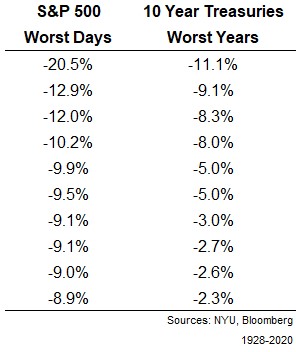It looks like you're new here. If you want to get involved, click one of these buttons!
how-to-invest-in-a-bubbleSome questions for an apathetic investor:
- What’s the right allocation for my risk profile and time horizon?
- What types of drawdowns would I be comfortable with?
- How to I balance risk and reward in my portfolio?
Historical market data can’t help you predict the future but I still find it useful as a way to understand the potential risks and rewards you can see as an investor.

Stock, Bond & Cash Returns: 1928-2020Looking through 93 years of returns for stocks, bonds and cash won’t help you predict future returns for these asset classes.
But it can give you a better sense of the risk involved in these asset classes since risk is much easier to predict than returns.
Moreover, asset price inflation in bonds one could argue is good for the bottom 90% who more often have outstanding debt than own financial securities in any significant amount. Debt with low interest rates saves them money. The people low yielding high priced debt hurts the most are bankers, i.e., creditors.The richest 1 per cent of Americans now account for more than half the value of equities owned by U.S. households, according to Goldman Sachs....As of September 2019, the bottom 90 per cent owned US$4.6 trillion of equities, or 12 per cent of the total, the analysts noted.
You continue to view inflation as a pricing phenomenon of products and services (“Will inflation return?”, December 12th). But this misses where inflation is hiding in plain sight: asset prices, notably in the increase in prices of investment assets such as property and speculative equity. The way we measure inflation and where we look for it needs a long-overdue change.
NAEEM HUKKAWALA
New York
Warnings?@BT2020:But go ahead and keep pushing highly leveraged and/or non-liquid funds...
So what's next?
Are you going to start pushing 2x and 3x leveraged funds like Profunds & Direxion too?
I already posted several warnings and what I have done with my own portfolio.
© 2015 Mutual Fund Observer. All rights reserved.
© 2015 Mutual Fund Observer. All rights reserved. Powered by Vanilla